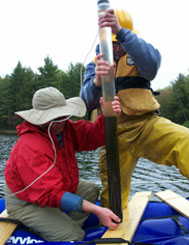RESEARCH
 My research focuses on environmental change and the study of Quaternary environments since the last glacial maximum. I’m interested in the relations between climate, vegetation, and disturbance such as fire. How these components interact over long time scales is particularly intriguing to me and frames the basic questions that motivate my research. Questions such as: What is the disturbance history of a particular place? How has the disturbance regime affected humans living in the area? Are humans responsible for changes in the disturbance regime? How have disturbance regimes, such as fire, changed over time and what has been the effect on forest vegetation? How much control does regional climate have versus local conditions in terms of vegetation response to climate change?
My research focuses on environmental change and the study of Quaternary environments since the last glacial maximum. I’m interested in the relations between climate, vegetation, and disturbance such as fire. How these components interact over long time scales is particularly intriguing to me and frames the basic questions that motivate my research. Questions such as: What is the disturbance history of a particular place? How has the disturbance regime affected humans living in the area? Are humans responsible for changes in the disturbance regime? How have disturbance regimes, such as fire, changed over time and what has been the effect on forest vegetation? How much control does regional climate have versus local conditions in terms of vegetation response to climate change?
The ultimate goal of these questions is to provide a clearer understanding of the interactions between humans, the biosphere and climate, so that we can make more accurate predictions of how these systems will interact in the future globally-warmed world. Interested students can take part in different aspects of this research including fieldwork and examination of the lake sediment in the lab. Please feel free to contact me at: longco@uwosh.edu
CURRENT RESEARCH AREAS:
Effects of disturbances on forest composition and successional pathways
Events such as widespread fires and volcanic eruptions may have important long-term effects on forest vegetation. The rate at which vegetation recovers and the opportunities for successional pathways to shift may vary depending on the type of disturbance or a change in the disturbance regime. I am currently examining the impact of volcanic eruptions on vegetation at several sites in the Cascade Range of Oregon and Washington and looking for synergistic relations between these events and fire. The goal of this research is understand the impact of these disturbances in forested landscapes of the Pacific Northwest.
Long-term fire history and its controls
Large stand replacing fires have become more common in the United States over the last several decades. Much of this increase in the size and severity of fires has been attributed to changes in climate and or past management practices. Teasing apart these two factors and understanding the impact of each can be difficult unless there is appropriate and adequate baseline information on past fires and fire regimes. I am working to reconstruct the fire histories and fire regimes along transects in the Oregon Cascades, Oregon Blue Mountains and in the upper Midwest. In order to understand the impact that climate conditions (drought) or changes in forest composition (fuels) can have on fire regimes. The information gained from these studies will aid management decisions by providing site specific and regional characterizations of fire regimes and the past response of forest vegetation.
SELECTED PUBLICATIONS
Long. C. J., Power, M. J, and McDonald B. L. accepted. Millennial-scale fire and vegetation change in a mesic hardwood forest of southeastern Wisconsin. Journal of Quaternary Science
Long, C. J., Power M. J. and Bartlein P. .J. 2010. The effects of fire and tephra deposition on forest vegetation in the Central Cascades, Oregon. Quaternary Research DOI 10.1016/j.yqres.2010.08.010. {pdf link}
Marlon, J., Bartlein, P.J., Walsh, M.K.,Harrison, S.P., Brown, K.J., Edwards, M.E., Higuera, P.E., Power, M.J., Anderson, R.S., Briles, C., Brunelle, A., Carcaillet, C., Daniels, M., Hu, F.S., Lavoie, M., Long, C., Minckley, T., Richard, P.J.H., Scott, A.C., Shafer, D.S., Tinner, W., Umbanhowar, C.E. Jr., and Whitlock, C., 2009. Wildfire responses to abrupt climate change in North America, Proceedings of the National Academy of Sciences 106:2519-2524; doi 10.1073/pnas 0808212106. {pdf link}
Whitlock, C. Bartlein, P, Briles, C., Brunelle, A., Long C. J., Marlon J. 2008. Long-term relations between fire, fuel, and climate in the northwestern U.S. International Journal of Wildland Fire 17, 72-83. {pdf link}
Long, C.J., Whitlock, C., and Bartlein P. J. 2007. Holocene vegetation and fire history of the Coast Range, western Oregon, USA. The Holocene 17: 917-926. {pdf link}
Long, C. J., and Whitlock, C. 2002. Fire and vegetation history from the coastal rain forest of the western Oregon Coast Range. Quaternary Research 58, 215-225. {pdf link}
Wimberly, M. C., Spies, T. A., Long, C. J., and Whitlock, C. 2000. Simulating historical variability in the amount of old forests in the Oregon Coast Range. Conservation Biology 14, 167-180.
Long, C. J., Whitlock, C., Bartlein, P. J., and Millspaugh, S. H. 1998. A 9000-year fire history from the Oregon Coast Range, based on a high-resolution charcoal study. Canadian Journal of Forest Research 28, 774-787. {pdf link}
